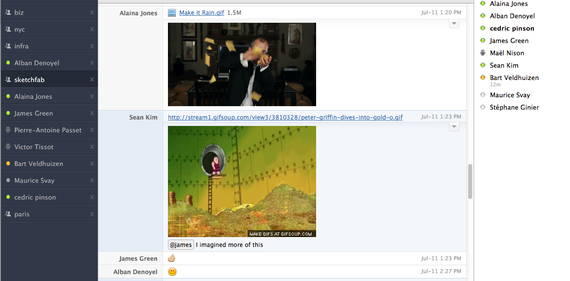It's a beautiful afternoon as I write this post at the Dineen coffee shop in Toronto. I'm also instant-messaging a co-worker in New York City, about to get on a Skype call with our community manager in the Netherlands, and sending an email to our development team in Paris.
Some may think this isn't an organized and efficient way to operate a growing company, but to us this is the future of work. Many of the greatest companies in the 21st century, including Virgin, 37signals, and IBM, have built successful businesses by providing people the freedom to work where they want, when they want, and how they want. Here's why: You get sh#t done. Shorter commutes, private offices, and flexible work hours mean less time wasted, more-productive work hours, and increased happiness amongst employees.
In 2013 researchers at Stanford University conducted a study by randomly assigning employees at a call center to work from home and others to work in the office for nine months. They found a 13-percent performance increase in those working from home, of which 9 percent was from working more hours.
Some employers criticize working remotely because they find it difficult to measure the number of hours that their employees are working. What they forget is that going into the office does not equal productive work. The Wall Street Journal reports:
Office workers are interrupted -- or self-interrupt -- roughly every three minutes, academic studies have found, with numerous distractions coming in both digital and human forms. Once thrown off track, it can take some 23 minutes for a worker to return to the original task, says Gloria Mark, a professor of informatics at the University of California, Irvine, who studies digital distraction.
Give people the freedom to work where they want, and begin to
rethink the 9-to-5 working style. By adopting a culture of trust and respect, you're empowering individuals to not just show up but show results.
We hear it over and over again: "Always hire the best people." The companies that embrace telecommuting have a significant advantage over those that haven't figured it out. For each candidate who is available to work in your city, there are hundreds more around the world who can do it better and cheaper. Hiring top talent is already hard enough as it is, so why limit the single most important ingredient for the success of your business? It's inevitable that more and more skilled workers will adapt to a remote working lifestyle, and it's the companies that can accommodate the lifestyles of these talents that will become the market leaders in the future.
The good news is that it's now easier than ever to coordinate the work of individuals from around the world. As long as we have access to a laptop and the Internet, we have access to hundreds of tools that have been created to make the process seamless.
Now, I'm not suggesting that it's all a walk in the park. There are drawbacks to working remotely, such as the inability to have the sorts of in-person interactions that might benefit training, instant feedback, and relationship building.
In any case, here's how to make working remotely work for you:
1. Think output.
Focusing on a results-orientated system is the initial step to take when going remote. At the end of the day, the output that we produce is the only tangible result that we can present that brings the business forward. I'm a huge fan of focusing on output because it forces me to put my focus on tasks that will have the biggest impact and helps me stay productive.
Too often we see this in today's working environment: Person A takes five hours to complete a project, and Person B takes 30 minutes to complete the same project. Person A comes in early and stays late at the office, while Person B can leave the office earlier to recharge or plan new projects that will bring value for the company. Yet Person A is rewarded for their "hard work" and dedication, even though Person B has accomplished the same outputs, if not more, from being productive.
Systems such as ROWE ("Results-Only Work Environment") are being introduced to promote output work cultures where employees are evaluated on performance, not on presence. It has been implemented at companies such as Best Buy and Gap. ROWE claims to bring about a 20-percent improvement in productivity, a 90-percent decrease in turnover rates, and increased customer satisfaction.
2. Get S.M.A.R.T.
Now that we're focused on results, we need to set the right goals and metrics for ourselves. Creating goals that are specific, measurable, attainable, realistic, and timely (S.M.A.R.T.) are the five most important factors to consider. Investing the time to plan and write down your S.M.A.R.T. goals will do wonders for your output.
If you're a coder, you could set a goal to release a certain feature in the next week. If you're in sales, it could be calling 50 people a day with a target to close 10 per week.
I encourage you to set your own goals, as you're the only person who knows your working style. But whatever goals you set, there's no better feeling than waking up each morning and having a clear target for exactly what you're going to accomplish that day, week, or month.
3. Communicate, communicate, communicate!
I can't stress this enough. The caveat to working remotely is that we miss out on nonverbal communication such as facial expressions, voice tones, and eye contact, which is said to account for up to 70 percent of all communication. When working from opposite sides of the world, communicating the smallest things is a must. This is why we at Sketchfab use HipChat as our instant-messaging tool. It allows us to keep in regular contact in an informal manner, and it allows me to be myself and have more naturally flowing conversations with my co-workers.
The beauty of working online is that it has forced me to articulate everything I communicate. Emails that would have been 750 words long have to be shortened to 300 words while getting the same message across. This has helped me keep my writing concise, which has transferred over to my speaking skills as well.
4. Create a company bulletin board.
All this means is having a project-management system or a "bulletin board" that allows each team member to see what everyone else is working on, because sometimes we get so focused on our own tasks that we forget what's happening with the rest of our team members. At Sketchfab we use Pivotal Tracker, but there are several other products that are just as effective, such as Basecamp, Asana, and Trello. This helps me understand what the high-level priorities for the company are and allows me to assign tasks to any team member without having to bug them about it.
5. Have regular feedback.
It's difficult to know if your work is producing the impact that your team members expect when working remotely. You can never have too much feedback, because we can always improve our work, become better team members, and have greater impact. So design a structure for regular individual feedback, whether it's biweekly or monthly. Creating a culture for continual improvement will allow team members to feel that they're personally improving, which leads to increased work engagement and greater loyalty for the business.
Avoid using email, and instead take feedback to video chats as much as you can. You can't risk leaving out your nonverbal communication for something as personal as individual feedback.
* * *
In order to build a successful business in a talent-shortage economy, we have to hire the best people , period. The opportunity to tap into a global talent market has never been more possible in the world that we live in.
The future of work is already here. It's up to you to take advantage of it.
* * *
This blog post was originally published on Sketchfab's blog.

